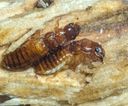Drywood and Dampwood Termites
Kalotermitidae
Classification
- Phylum: Arthropoda
- Subphylum: Hexapoda
- Class: Insecta
- Order: Blattodea
- Superfamily: Blattoidea
- Family: Kalotermitidae
Pronunciation
How to pronounce Kalotermitidae: /ˌkæloʊˌtɜːrmaɪˈtɪdiː/
These audio files are automatically generated. While they are not always 100% accurate, they are a good starting point.
Images






Summary
Kalotermitidae, also known as drywood termites, are a family of termites characterized by their primitive morphology and exclusive wood-dwelling lifestyle, with significant economic implications due to their pest status.
Physical Characteristics
Kalotermitidae exhibit a primitive morphology and lack elaborate nesting architecture. They have mandibles fortified with zinc, adapted for consuming dry wood.
Identification Tips
Identification may be challenging due to their small size and lack of obvious external signs, as they often leave little evidence of their presence within wood.
Habitat
Kalotermitidae live exclusively within excavations in wood and are found in functionally arid environments, often within structures such as furniture, utility towers, and buildings.
Distribution
Kalotermitidae have a cosmopolitan circumtropical distribution with approximately 18 species in 8 genera locally and around 450 species in 21 genera worldwide.
Diet
These termites primarily consume dry wood, which they can digest thanks to symbiotic flagellates in their gut.
Life Cycle
The Kalotermitidae undergo a hemimetabolous lifecycle, lacking a distinct pupal stage. Their immatures can serve as temporary workers before transitioning into adult forms.
Reproduction
Kalotermitidae are eusocial with flexible caste distinctions; they lack a true worker caste, utilizing pseudergates as temporary workers. Dealates mate for life after dispersal flights.
Ecosystem Role
Kalotermitidae contribute to the breakdown of dead wood, impacting nutrient cycling within their habitats.
Economic Impact
Their diet of dry wood often makes them pests, causing damage to various wooden structures and items, including furniture and buildings.
Evolution
Kalotermitidae represent a monophyletic group within the lower termites, showing instances of long-distance transoceanic dispersal in their evolutionary history.
Similar Taxa
Misconceptions
There is a common misconception that all termites require contact with soil; however, Kalotermitidae live entirely within wood excavations and do not require soil contact.
Tags
- Drywood Termites
- Kalotermitidae
- Eusocial Insects
- Pests
- Arid Environments